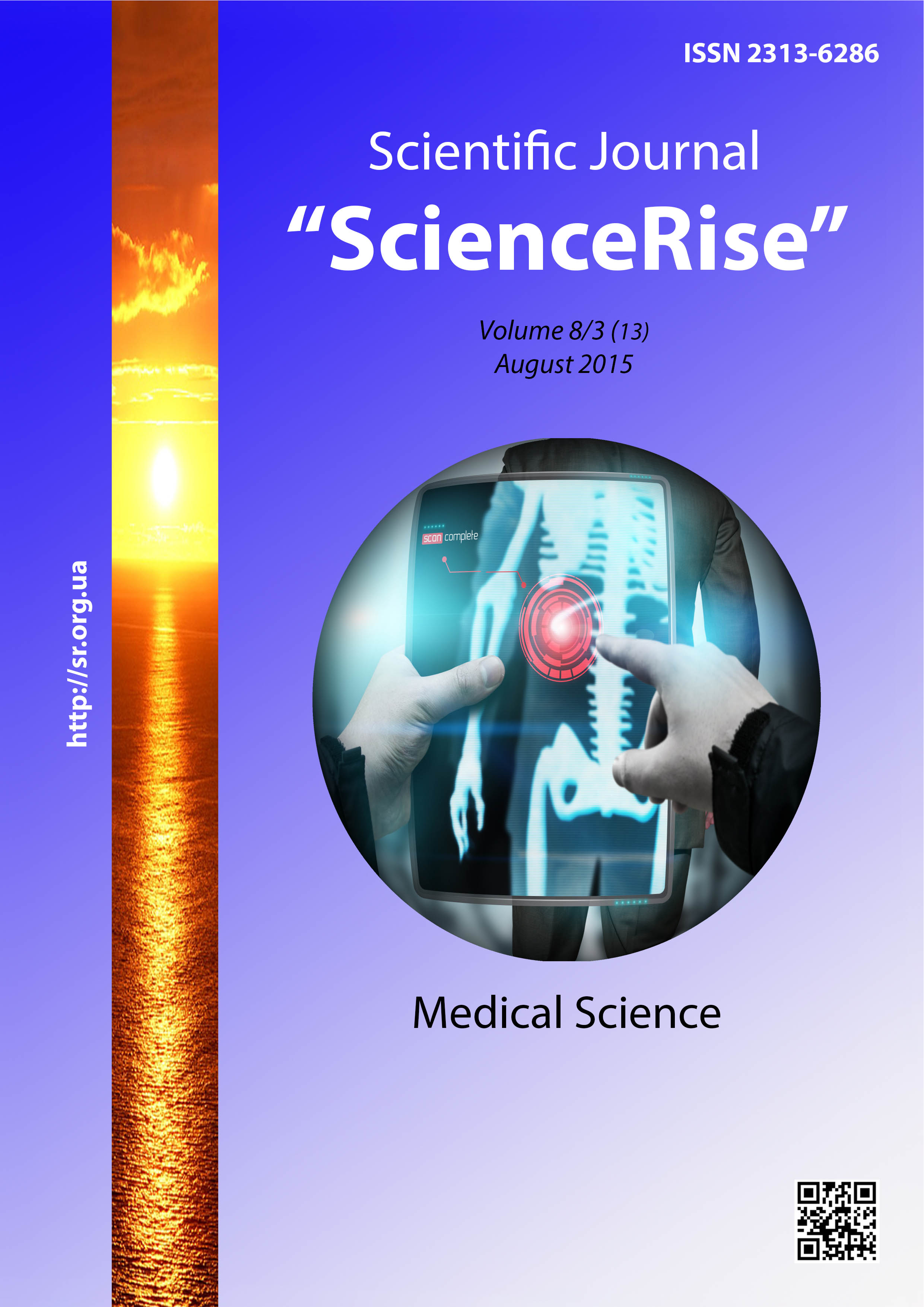Dynamic stereotype and vegetative regulation corection in childrens with effects of organic lesion of nervous system
DOI:
https://doi.org/10.15587/2313-8416.2015.47713Keywords:
children with effects of organic lesion of nervous system, physical rehabilitation.Abstract
Aim of research. An assessment of the CNS state, neuropsychological indicators and influence of the modern methods of physical rehabilitation on the dynamics of vegetative adaptive and compensatory brain systems in patients with effects of an early organic lesion of nervous system.
Materials and methods of research. There were examined and treated 20 children 7-11 years old. An assessment of vegetative homeostasis was carried out using cardiointervalography (CIG), neuropsychic functions and deficiency of statomotor development – the method of Luriya neuropsychological testing. The children of the first group (10 persons) underwent massage and therapeutic physical training with special attention to the dynamic stereotype in complex with generally developmental, breathing, special passive and active, static and dynamic exercises, postisometric relaxation, massotherapy. The patients of the second group (10 persons) underwent traditional therapeutic physical training and massage.
Results of research. It was observed an inhibition of the humoral control of heart rate in examined children and at the same time an activation of sympathetic system. As a result it was detected an increase of the stress index of compensatory reactions of organism (stress index SI — 124 un. at the norm 65,0 ud.). Neuropsychological features of these patients indicated the presence of the left hemispheric and less right hemispheric deficiency, dysfunction of subcortical and stem structures.
The use of the complex methodology of rehabilitation with special attention to the dynamic stereotype and manual therapy according to the aspects of genesis of myofascial dysfunction favored an optimization of the stress of compensatory mechanisms of organism (SI — 51,0 un.). In the second group it was observed a stable activity of sympathetic regulation of the heart rate compared with indicators before treatment and an insignificant decrease of the stress index of vegetative balance (SI — 74,0 un.).
The more significant dynamics of the state of the high integrative functions and indicators of visual and auditory gnosis was also attained in the first group of treatment.
Conclusions. The use of schemes of treatment according to the state of organization of the motor functions, aspects of genesis of myofascial dysfunction with special attention to vegetative regulation favor an increase of the level of high cortical functions and ensure the regulative influence of central structures on motility and regulation of the heart rate.
References
Petrov, К. B. (2011). Development and perfection of thesyndromic-oriented approach in the rehabilitation. Curative physical education and sportingmedicine, 5 (89), 51–57.
Yevtushenko, S. К., Shtutin, А. А., Fistal, E. A., Honcharova, Y. A. (2010). Differentiated therapy of neurovascular syndromes. Announcer of urgent and reabilitation medicine, 11, 85–93.
Laskar, A. R., Gupta, V. K., Kumar, D., Sharma, N., Singh, M. M. (2010). Psychosocial effect and economic burden on parents of children with locomotor disability. The Indian Journal of Pediatrics, 77 (5), 529–533. doi: 10.1007/s12098-010-0064-7
Davis, E., Shelly, A., Waters, E., Boyd, R., Cook, K., Davern, M. (2010). The impact of caring for a child with cerebral palsy: quality of life for mothers and fathers. Child: Care, Health and Development, 36 (1), 63–73. doi: 10.1111/j.1365-2214.2009.00989.x
Simmernickaya, E. G. (1985). Man's Brain and psychical processes in ontogenesis. Moscow: Moscow's University Publishing, 192.
Popov, S. N. (2004). Physical rehabilitation. Rostov on Don: "Fenics", 608.
Phisenko, L. I. (2005). Physical culture in sanatorium. Кyiv "Кupriyanova", 400.
Martinyuk, V. Y., Zinchenko, S. M. (2005). Bacis of the medical-social rehabilitation of children with the organic defects of the nervous system. Educational method. manual. Kyiv, 416.
Downloads
Published
Issue
Section
License
Copyright (c) 2015 Наталия Юрьевна Гришунина, Максим Валерійович Манін

This work is licensed under a Creative Commons Attribution 4.0 International License.
Our journal abides by the Creative Commons CC BY copyright rights and permissions for open access journals.
Authors, who are published in this journal, agree to the following conditions:
1. The authors reserve the right to authorship of the work and pass the first publication right of this work to the journal under the terms of a Creative Commons CC BY, which allows others to freely distribute the published research with the obligatory reference to the authors of the original work and the first publication of the work in this journal.
2. The authors have the right to conclude separate supplement agreements that relate to non-exclusive work distribution in the form in which it has been published by the journal (for example, to upload the work to the online storage of the journal or publish it as part of a monograph), provided that the reference to the first publication of the work in this journal is included.

